Teen Had Half Her Brain Removed as a Baby — Now She’s Living a ‘Glass Half-Full Life’ (Exclusive)
Before Mora Leeb was born, she had a stroke that destroyed the left side of her brain. Doctors removed the damaged areas, and today she plays tennis, tells jokes, wins at Uno – and lives a life of possibility
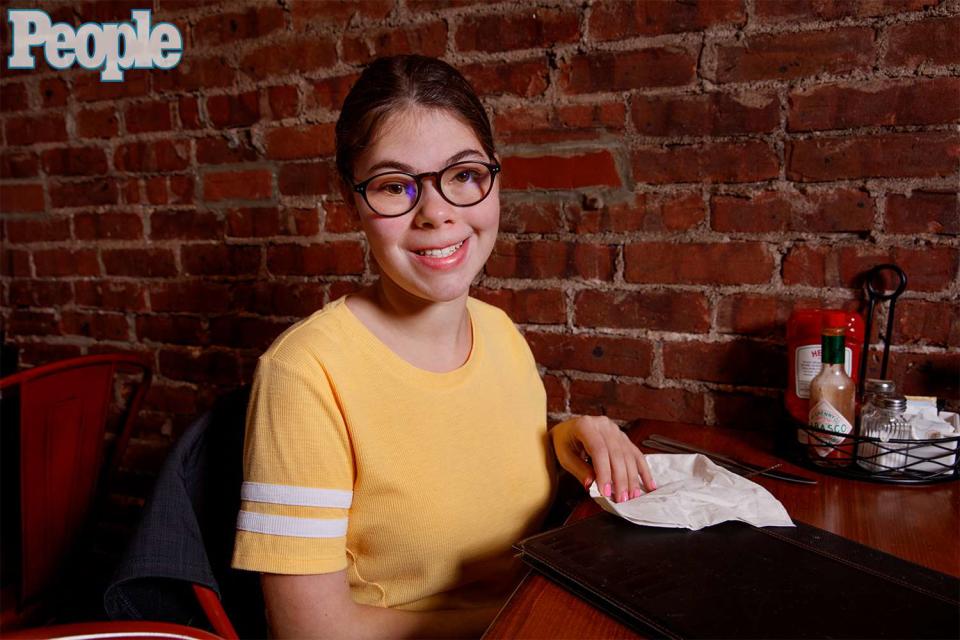
Elinor Carucci
Mora Leeb photographed for PEOPLE, October 2023.When Mora Leeb was four months old, she began experiencing seizures. Her parents learned she had had a stroke in utero that had destroyed most of the left hemisphere of her brain and caused epilepsy. Medication wasn’t able to control the hundreds of seizures she was having every day, so her parents made the difficult decision to have Mora undergo a hemispherectomy: doctors removed the damaged tissue on the left side of her brain. Her right side has since had to adapt, taking on jobs normally done by the left, like speech and language. But with a circle of support and years of hard work, Mora is living a full life as a teenager in New Jersey. Mora and her family have shared their story in this week’s issue of PEOPLE magazine.
Mora Leeb walks through the doorway on a recent October afternoon with an energetic bounce. She stretches out her left arm for a hug. “Hi!” she says with a bright smile, turning to a table in front of her where a loaf of chocolate chip pumpkin bread is wrapped in tinfoil.
Before cutting into the bread, which she baked for the occasion, she has a joke for her visitor: “What do you call a writer that doesn’t follow sentence structure?” she asks. Much of her speech is slow, deliberate, almost robotic. Then the punchline tumbles out: “A rebel without a clause!” She follows with a laugh, and soon she’s dealing cards for a round of UNO FLIP!, which she plays (and wins) while munching on pumpkin bread.
It’s a charming but otherwise unremarkable introduction to this 16-year-old from South Orange, N.J., — until you understand the underlying triumph of the moment. Each ordinary action — walking, talking, reading a recipe, dealing cards, joking — has involved a painstaking learning process.
Mora has grown up without the use of the left side of her brain, after doctors removed it to stop the rampant seizures she experienced as an infant. Her right hemisphere has adapted to take on speech and language functions normally performed by the left, and she has had to push herself to use the weaker right side of her body.
Related: 6-Year-Old with Rare Disease Has Half Her Brain Disconnected
“It blows my mind to think how far she’s come,” says Alexandra Clayton, director of therapy services at Intensive Therapeutics, a therapy center in West Caldwell, N.J., for children and young adults, where Mora has gone weekly since she was a toddler, unable to speak. “She’s one of the most determined people I know.”
But Mora, who has learned to ski and sing and play Sudoku, sees her success differently: “I don’t think what I’m doing is so amazing. Other people do these things too.”
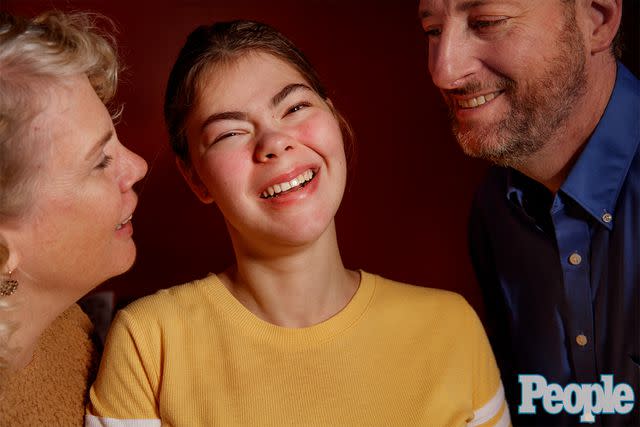
Elinor Carucci
Mora Leeb with her parents Ann and Seth, photographed for PEOPLE, October 2023.A Shocking Discovery
When Mora was born in September 2007, “everyone said, ‘Here’s your beautiful little girl. Perfect,’” recalls her mom, Ann, 59, who thought her pregnancy had been normal and healthy. “It was a very happy time.”
Mora was the first child for Ann and her husband Seth, and they named her in honor of Ann’s father, Morris, who had died more than a decade earlier. “Mora means teacher in Hebrew,” says Ann. “When we selected her name, we had no idea how much Mora would teach us.”
For the first three months Mora made her milestones: She nursed; she rolled over; she smiled—and then it came to a standstill.
The seizures began when she was 4 months old, barely noticeable at first — but by February 2008 they were clustering 20 per minute, hundreds in a day. “When a baby's having seizures that are that frequent, the brain is not doing any of its normal functions,” says Dr. Prakash Kotagal, a pediatric epileptologist at Cleveland Clinic who has treated Mora. “Their development not only stagnates, but actually regresses.”
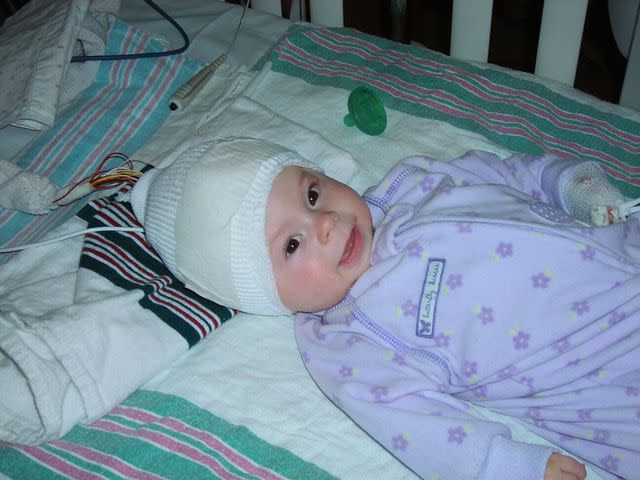
Courtesy Leeb Family
Mora Leeb in March 2008 wearing brain monitoring equipment.All of Mora’s milestones began to disappear and she was no longer smiling or rolling over. When doctors showed Ann and Seth, 55, scans of their daughter’s brain, “you didn’t need a medical degree to understand it. There were huge black areas in the left hemisphere,” Ann says. Mora’s severe epileptic seizures, they learned, had been caused by a massive stroke she had experienced in utero.
Related: Mega-Influencer Camila Coelho Reveals She Has Epilepsy: 'I'm Grateful for My Life Every Day'
“A doctor explained that Mora’s brain had taken a pounding,” Ann says. The doctor told them if the damage and seizures could be contained to the left side, the right side could continue to function normally. “But there’s a large band of neurons that connects your left hemisphere to your right hemisphere called the corpus callosum,” Ann says. “And if the seizure activity migrates in some way across corpus callosum to the right, you're going to have a brain that really can't function at all.”
A Difficult Decision
Doctors tried to control the seizures with medication, but the drugs had little effect. A more drastic option was presented: surgery to remove the damaged half of their daughter’s brain — an operation known as a hemispherectomy. At first “we were stunned,” says Ann.
But the couple decided Mora’s best chance was surgery and they turned to Dr. William Bingaman, a neurosurgeon and head of epilepsy surgery at Cleveland Clinic. “If you stop the damaged hemisphere from seizing, you allow the good hemisphere to begin to develop, and patients are able to be at the best cognitively that they can be,” says Dr. Bingaman, who does up to 40 hemispherectomies each year. (About 150 are performed in the U.S. annually.).
In June 2008, when Mora was 9 months old, Dr. Bingaman and his team removed her damaged brain tissue. It was like a reset. “Mora was reborn for all the possibilities,” Ann says. “We are all about maximizing potential. We didn’t know what that could be for Mora, but we thought, ‘Let’s do what we can do.’”
For the Leebs, that has meant creating a circle of support around Mora with their other family members, in their synagogue, in their community and beyond. They sought advice from other families with children who had undergone hemispherectomies, and they quickly got Mora into speech and occupational therapy. “Life is not normal and it is hard work for Mora and her family,” says Dr. Kotagal. “But they've done a remarkable job. She has made remarkable progress.”
Mora's Hard Work
That progress hasn’t come easily or quickly for Mora. She began walking at 23 months, didn’t speak in sentences until she was 6, and she was 8 when she was learned to tie her own shoes.
She’s further challenged by the fact that her visual field is cut in half — she can't see out of the right side of each of her eyes. When Mora first came to Intensive Therapeutics at the age of 2, “she wasn't seeing her right hand, right arm, right leg. It wasn't being perceived,” explains Scott Matthews, founder of the center.
Each summer, Mora has participated in the center’s Camp Helping Hands, where Clayton, Mora’s primary occupational therapist since childhood, remembers meeting Mora. “Every day she would run through the door and go to the back left corner. We thought she was trying to escape, but she didn't know that that whole right side of the room was there,” she says. “She's learned to compensate for it and turn her head more.”
At the camp and during her weekly OT sessions, Mora has been pushed to use the weaker right side of her body with techniques like wearing a cast on her dominant left arm that forced her to use her right.
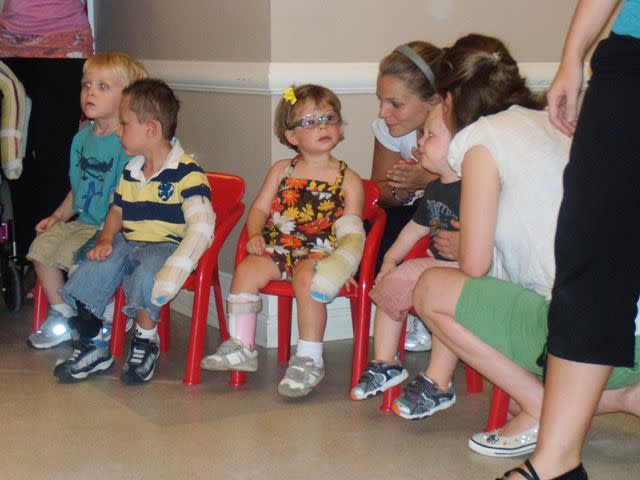
Courtesy Leeb Family
Mora Leeb (center in glasses) at Camp Helping Hands in 2010, wearing a cast on her dominant left arm to encourage the use of her right arm.But everyday tasks for the teenager still take countless hours of practice. Two years ago, she mastered putting her own hair in a ponytail. “We worked tirelessly,” Alexandra Clayton says of the accomplishment.
A Scary Setback
Five years ago, Mora was about to tackle another big goal — riding a bike, an activity made all the more difficult by her restricted vision — when she had a medical setback. Her seizures returned and she again needed surgery. Her first operation was what is known as a “functional” hemispherectomy in which the left hemisphere was disconnected from the right and the damaged tissue was removed but some brain tissue was left intact. In August 2018, Dr. Bingaman’s team went back and removed the remaining tissue (spinal fluid fills the emptied cavity) in hopes that the seizures would stop.
Related: Toddler Thriving After Doctors Cure Her Seizures by Intentionally Inducing Strokes in Her Brain
“I was probably more concerned about Mora before the second surgery than the first,” says Ann. “Mora had come so far at that point – she was nearly 11 — and she was a person with her own style, sense of humor, charm. Would she regress in all the skills she possessed? Would something go wrong on the operating table? At her level of cognition, she needed explanations that she didn't need as a baby. Would we frighten her, traumatize her?”
But Mora managed to recover quickly and was even dancing at a family member’s wedding by December. “That's really a tribute to who she is. These things that I think would faze a lot of other people just don't seem to faze her that much,” Ann says.
Determined to Learn
Mora has continued to cope with medical complications — she is on anti-epileptic medication, she receives Botox injections in her right hand, arm and leg twice a year to keep her muscles loose and she lives with Crohn’s disease as well — but “through all of it, Mora has just kept going,” Ann says. “Yes sometimes, Seth and I would just want to throw in the towel and say enough already, but we keep going, too. How could we let Mora down?”
That steady support has been a big part of Mora’s success. “Mora really lucked out because her parents are people that aren’t ever going to give up,” says Dr. Bingaman. But, Seth says, he and Ann feel like the fortunate ones: “I feel very lucky. Mora is just fun to be with.”
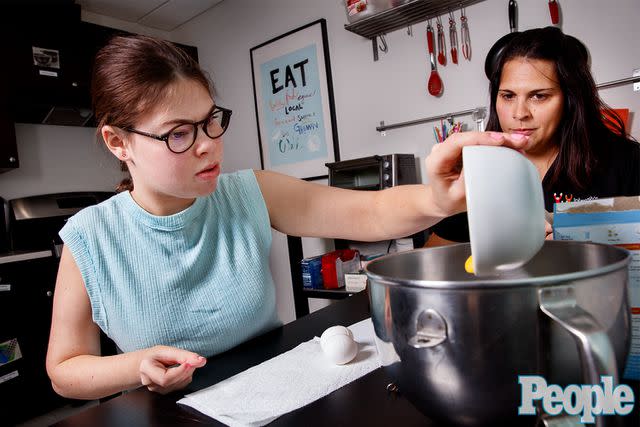
Elinor Carucci
Mora Leeb and her occupational therapist Alexandra Clayton baking pumpkin bread in October 2023.Nearly three years after her second surgery, in 2021, Mora stood in front of her synagogue congregation, and hundreds of others tuning in via Zoom, to give her Bat Mizvah speech. “Personally, I can be described as a ‘glass half full’ girl,” she told the crowd. “There are challenges in my life. Things can be difficult. As a family we know that well, but we try to keep moving forward and hope for good times ahead.”
Mora remains committed to taking on challenges, including returning to difficult work of learning to riding a bike. “I am interested in learning most everything,” Mora says. And says Matthews, “the possibilities are endless if she puts her effort into it—and she will, because that’s who she is.”
Her 'Glass Half Full' Life
Today Mora is a ninth grader studying algebra, Spanish and chorus. Her bedroom, decorated in shades of pink and purple, is packed with books (a dictionary of antonyms, a book of idioms, a recent read, Best Wishes Book 1 by Sarah Mlynowsky), a collection of silly sunglasses adorned with pink flamingos, parrots and shamrocks, and a pillow on her bed that reads “Today is Going to be Altogether Awesome” — a prize for selling Girl Scouts cookies.
She proudly shows off her manicured bubblegum pink fingernails and her new sparkly pink earrings (getting her ears pierced was her 16th birthday present). On a recent outing, she went to see Taylor Swift; The Eras Tour concert film.
In so many ways, Mora is a typical teen, but her communication skills are still very slow which means it can be difficult for her to make close friends. “If you're a teenager and you want immediate answers, you're not going to get it from her,” says Seth, an architect who owns his own firm. But “you'll get the answer if you're patient. And we don't want things dumbed down. You don't have to treat her like a four-year-old. You just have to be patient with a 16-year-old.”
In person, she can expertly explain the rules for UNO FLIP! and how she packs up the thousand-plus Girl Scouts cookies she sells every year (each with a personal note to the buyer). But abstract questions are harder to process and elicit long pauses — and sometimes only silence. Given time, however, she responds thoughtfully, in a series of videos she sends later. “She won’t give up on things,” Seth says. “She never talks about her weaknesses. She will often say, ‘I can do this.’ And she’ll work at it to do it.”
When she’s not taking tennis lessons (she started learning in 2017) or reading a favorite book (a dictionary of 700 idioms is top of the list), Mora spends time helping researchers understand how the brain can adapt to trauma.
The Leebs were connected with several of the researchers through a group called the Pediatric Epilepsy Surgery Alliance, which provides support for families, advocates for research and offers an epilepsy surgery registry where families like the Leebs can share their experiences. “When you talk to a doctor about hemispheric surgery and ask, ‘How will my child be afterwards?’ most of the time they'll say, ‘We really don’t know all the long-term side effects of surgery,” says alliance founder and executive director Monika Jones. “Now we’re starting to inform the clinical community.”
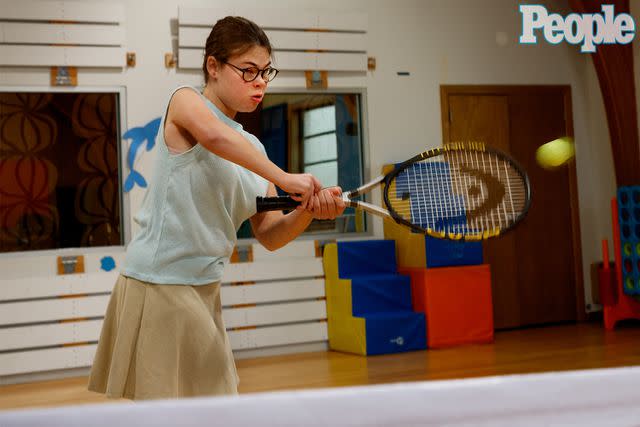
Elinor Carucci
Mora Leeb playing tennis at Intensive Therapeutics in New Jersey, October 2023.Mora has already participated in six studies, and she meets every month or two to help train medical students at Rutgers University. She also enjoys volunteering with a youth group at her synagogue that’s engaged in community service. Giving back “is part of our values as a family,” says Ann. “Yes, Mora’s got all these issues. Those are the lemons. This is the lemonade: She has something to contribute, and it’s meaningful.”
For Mora, while the future is uncertain, she says she'd like to become an accountant, and her parents hope she can work toward an independent life. Mora sounds ready for the challenge. “I call myself ‘the glass half-full girl,’ because I am optimistic about myself,” she says. “I think things are going to be good, and I am going to be happy.”
For more on Mora Leeb, pick up the latest issue of PEOPLE, available on newsstands this Friday.

Elinor Carucci
Mora Leeb and her parents Seth and Ann photographed at home in New Jersey for PEOPLE in October 2023.For more People news, make sure to sign up for our newsletter!
Read the original article on People.

